Shangri-La is the name of an East Asian hotel chain, the national airlines of Nepal, and other Asian institutions that promise happy times to their clients. It is also, more famously, a fictional land of perfect harmony. In his 1933 novel, Lost Horizon, James Hilton wrote about a diplomat and his three companions who survive a plane crash in the snowy mountain peaks of North-Central China. They find themselves in Shangri-La, a land of peace and wisdom where a sect of monks presides over residents who live for hundreds of years.
Hilton modeled Shangri-La on the mystical kingdom called Shambhala in ancient Tibetan Buddhist texts. High up in the Himalayas, it is said this secret place will give a new king to mankind who will ultimately defeat all evil and lead the world into eternal peace. The Theosophical Society familiarized the West with the Shambhala myth around the turn of the 20th century. Hilton, as well as Frank Capra who made a film of the novel in 1937, served up much needed utopian hope to the Depression-struck Western world threatened by a new World War.
Several Chinese towns near the Tibetan Autonomous Region claim to be the actual model of Shangri-La, the literal translation of which is “the peach river-source away from the world.”1 In 1997, the Chinese government, shifting the game away from the brutal oppression of Tibet and its spiritual leaders toward business, officially awarded the name Shangri-La to the small, rural town Zhongdian in the area. This name change inspired Patty Chang to visit Shangri- La, participate in its developing story, and document the experience in a thirty-minute video commissioned by Hammer chief curator Russell Ferguson.
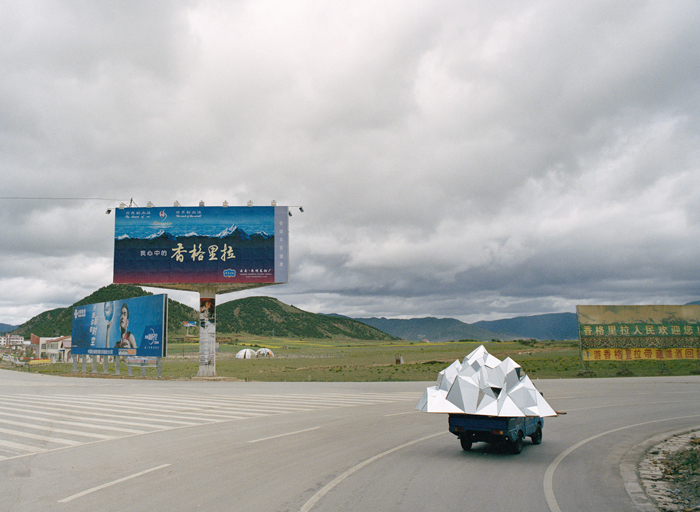
After a breathtaking first view of the town at the foot of a towering mountain, shot by Chang as her plane pierced the clouds as it nears the Shangri-La airport, all that is seen of the majestic peak are its variations in the town logo, on billboards and on decorated cakes. Shangri-La turns out to be a bleak, dusty place where a lot of construction work takes place under overcast skies.
An artist previously known for transgressive performances centered on her own body, Chang immerses herself in her new environs. At one point in the video, she follows a group of young monks (who wear sneakers under crimson robes) as they enter the atrium of a new luxury hotel. A clerk, apparently in charge of controlling visitors, restricts Chang to lower levels of the hotel and bars her from shooting an oxygen chamber where altitude sickness is treated. Soon thereafter, Chang sets up shop in a shed that, in strong contrast to the well-built and well-guarded hotel, is protected from the gusty winds by a flimsy piece of canvas. She instructs a group of hired local craftsmen to build a replica of the oxygen chamber, as well as an eight-foot likeness of the mountain from wood and foam. Eventually, foam proves inadequate and the wooden structure is covered by pieces of mirror, cut to the shape of the mountain’s faceted surface.
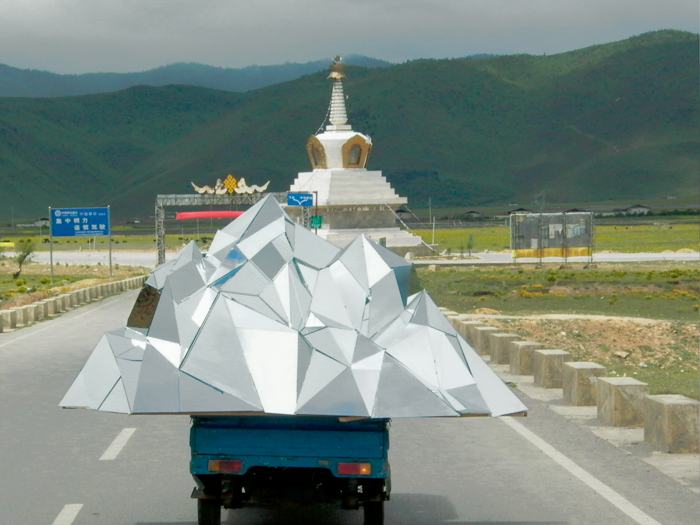
Dozens of angled surfaces on the pyramid- like rendition (a version of which is recreated at the Hammer Museum) mirror the sky, landscape, people, and various objects as they appear in its vicinity. Chang then sets the mountain in motion by bolting it to the bed of a tiny blue pick-up truck. As she stated, she wished for the mountain “… to reflect its environment. In the landscape, it becomes very small; with people surrounding it, it becomes human size.”2 Chang’s mountain absorbs everything visible around it and throws back only disembodied images. As the silvery, abstract sculpture travels past the somber brick-and-mortar reality of road signs, milestones, and billboards, it is as unreal as a Christo wrap. Before long, it begins to function as a glaring allegory about the fiction the town has chosen as its new foundation.
Almost four decades after Guy Debord’s book The Society of the Spectacle described the power of images over the reality they mediate, the conflict of reality and its image has morphed into a duality of fact and fiction. For Debord, commercial images of a “consumer paradise” began to take the place of reality in the minds of television viewers. He wrote, “The spectacle is the bad dream of modern society in chains, expressing nothing more than its wish for sleep. The spectacle is the guardian of that sleep.”3 Working in China, Chang captures both the more quotidian and global impositions of this guardianship. In her Shangri-La project, which documents the process in the making, she reveals the gaps between the hard reality of ruthless methods devised by political powers and the sweetness of the Shangri- La fantasy—a conflict that will likely be rendered invisible in the end product, the emerging city. Chang enters the spectacle of an already fictionalized reality. Her presence and outsider’s gaze are indicators of an external normalcy, which reflect, as does her mirrored mountain, the unlikely narrative she experiences.
Conceptually, her rough-hewn mountain teeters on the border of fiction and reality, social and esthetic, virtual and real, exactly as does the dirty town that fancies reinventing itself. The video’s sound effects mark the rift between fact and fiction: the incessant flurry of wind and rough, clattering noises sound the harshness of nature rather than the harmony of heaven. What becomes obvious is that re-packaging this town to sell happiness will not make its townsfolk happy, free, or afford them religious autonomy. Instead, the residents of Shangri-La have become props in a life-sized commodity.
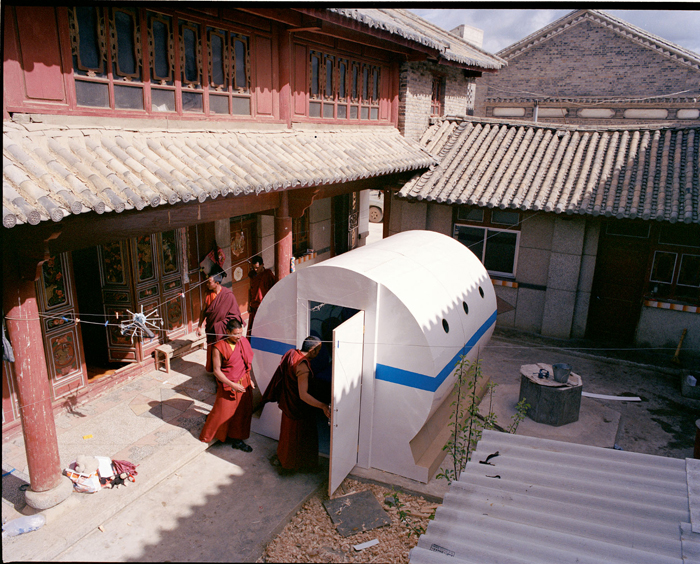
Oscillating between eco art, political commentary, performance, and filmmaking, Chang’s video exhibits a return to the critical consciousness of the ‘60s and ‘70s, a trend that has become increasingly conspicuous in recent art. While exposing the fictitiousness of Shangri-La, Chang reveals the bigger social lie behind the commercial one. Recently, Chinese film director Jia Zhangke commented, “In Chinese society today there are a lot of moments where what is going on could be called a show.”4 In her video, Chang enhances the notion of a “show” by the introduction of a subplot. Playing on local attempts to transform Shangri-La into a popular wedding site, she hires professional photographers to produce enticing images of her and cinematographer David Kelley as newlyweds. Chang also commissions a wedding cake upon which the features of the symbolic ice- capped mountain and the futuristic oxygen cabin are clumsily depicted in frosting.
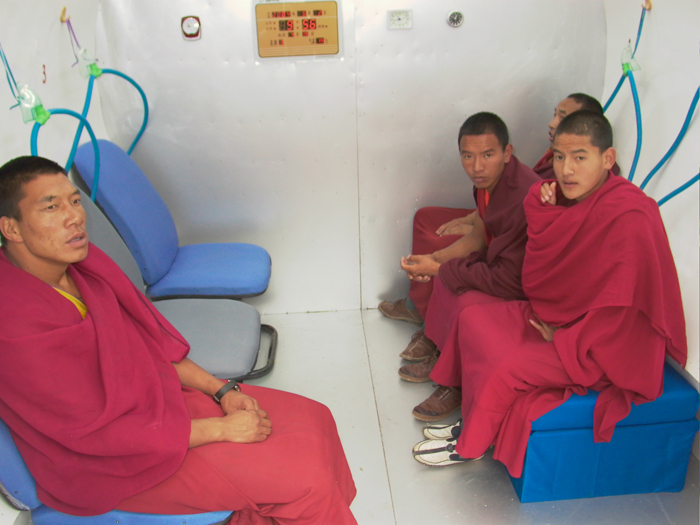
The faux wedding represents another aspect of China’s “officially sanctioned virtual reality,” the same kind of carefully engineered emergence of which is the subject of Zhangke’s films. Chang’s turn as Las Vegas- style bride commingles the solemnity of religious tradition and commitment vows with the serious business of free trade. To make her point even more explicit, Chang films the wedding cake as it is being frosted in front of a TV set, the tawdry electric colors of which blend with those used for decorating the sugary pastry.
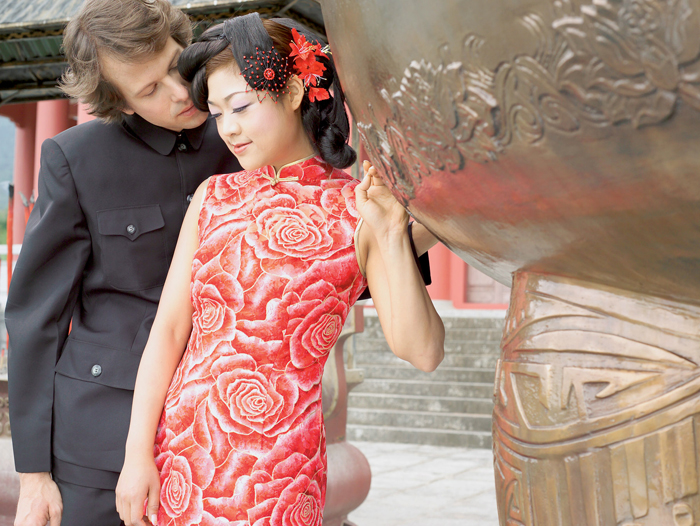
Shangri-La dryly documents the town’s calculated slippage from reality into fantasy, conducted under the watchful scrutiny of an authoritarian government. Zhongdian, a place where pigs wander dirt roads but that also boasts a Western-style beauty parlor, is being transformed with the active cooperation of its populace into a spiritual theme park of sorts. The newly renamed Shangri-La is bound to provoke a medley of cross-cultural misunderstandings posing as global concepts as it strives to attain heavenly happiness under strict earthly control. Chang arrives to catch this particular moment in the rise of China, where bureaucracy and capitalism merge in order to replace an ailing communist ideal with the presently more desirable Western dream. Chang holds her ground between the visual evidence of a reality that is still mostly laid bare and the emerging fiction that has been designed to cover it up.
Éva Forgács is a critic, art historian, and curator living in Los Angeles. She teaches at Art Center College of Design.
